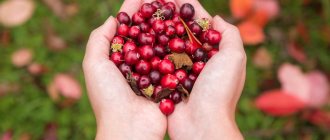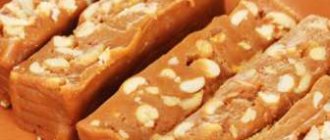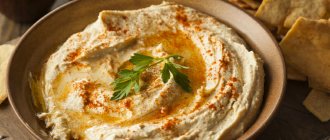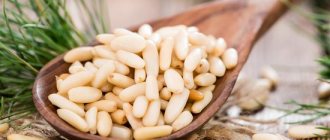Properties of whiskey
Nutritional value and composition | Vitamins | Minerals
How much does whiskey cost (average price for 1 liter)?
Moscow and Moscow region.
740 rub.
Along with cognac, whiskey is revered by numerous gourmets and connoisseurs of strong aromatic alcoholic drinks around the world. Whiskey is made from various types of grains (rye, barley, corn or wheat) through malting, distillation, and then long-term aging in oak barrels. The color of this elite drink can vary from pale yellow to deep brown, but the taste is quite difficult to describe. Some of our compatriots sometimes compare whiskey to good moonshine. The homeland and traditional regions where whiskey production is on a huge scale are Ireland and Scotland. Interestingly, the best and most expensive whiskeys are aged in barrels for at least 20 years.
Whiskey is generally consumed undiluted, but this strong drink is often diluted with a small amount of water or soda, as well as ice cubes. In any form, whiskey is drunk from transparent massive glasses with a rather thick bottom, which are called tumblers. The simplicity and elegance of these vessels emphasize the undeniable advantages of this noble drink. Drinking high-quality whiskey from glasses, shot glasses, wine glasses or ordinary glasses is considered bad form. The calorie content of whiskey, like vodka, for example, is 235 kcal per hundred grams.
You can enjoy whiskey as an aperitif or digestif, or simply to quench your thirst. In addition, this drink is widely used for culinary purposes, where it is often added to a variety of dishes or used in flambéing food - a small amount of whiskey is poured over the food and then set on fire. Thus, the alcohol is evaporated, leaving only a subtle aroma of the essential oils of the elite drink, which gives the finished dish a refined note.
The benefits of whiskey
Whiskey has the following beneficial properties:
- when consumed in moderate quantities (no more than 30–50 g), this drink stimulates the heart, increases vascular tone, and activates the functions of the nervous system;
- whiskey is saturated with antioxidants that inhibit the aging process of the body and prevent the formation of blood clots;
- during times of stress, whiskey relieves nervous tension;
- small amounts of such alcohol provide prevention of many diseases of the central nervous system, including those indicated for the prevention of Alzheimer's disease;
- whiskey after eating activates the process of digesting food;
- In many traditional medicine recipes, alcohol is used as an ingredient for the preparation of expectorants and anti-inflammatory remedies and compresses.
Whiskey varieties
Malt is a drink subject to filtration and distillation, taken exclusively from one barrel. As a rule, because of this it has a high strength, although it can be diluted to a certain level.
- Single malt - has a unique chemical composition, since it is produced by the same distillery, and can also have different long-term aging.
- Barrel is a mixture from different distilleries, because of this its composition cannot be called unique from a chemical point of view.
- The single malt drink has gained great popularity, in contrast to the cask drink, which is aged, like mixed malt, in oak barrels and is characterized by a strength of 40 degrees. The recipe was lost in the medieval years, however, it was restored in 1960 in Scotland. Previously, distillers believed that whiskey needed to be weakened solely through blending, since it had a strong taste and smell. As a result, new varieties of the drink were obtained, each of which has unique features and properties.
The vast majority of the grain type of drink is used for blending; as for a small part, it goes on sale in its unchanged pure form. If the drink undergoes additional purification, then in the future it will be used to produce vodka or gin. For the first, it is distilled about five times.Blended whiskey is made by blending malt and grain whiskey. The most popular drink, where the share of pure whiskey is more than 90%, and the remaining 10% consists of various ingredients.
Whiskey harm
Whiskey is a strong alcoholic drink that should be consumed in small quantities and not regularly. When whiskey is abused, alcoholism develops and irreparable damage is caused to all systems and organs of the body, including the heart and vascular system, nervous system, liver, stomach, and pancreas.
In case of chronic and aggravated diseases of the liver and gastrointestinal tract, you should completely avoid drinking whiskey and other alcoholic beverages.
SUBSCRIBE TO SITE UPDATES
Whiskey and cola is one of the most popular drinks primarily because of its simple preparation method and pleasant taste. However, the cocktail contains a large number of calories, so people watching their weight and leading a healthy lifestyle should be careful about consuming this drink.
Calorie content of alcoholic cocktails
The composition of whiskey is largely determined by the country of its production and the manufacturing company. Cereals (malt) are used as the basis for the drink: barley, corn, rye or barley. The raw materials are germinated, subjected to a fermentation process, distilled and aged in oak barrels.
Scottish and Irish producers mainly use barley to produce whiskey, which gives the drink a special taste and aroma, saturates it with vitamins and microelements. In the USA and Canada, corn is most often used as a raw material. It is not germinated, thereby significantly reducing the cost and speeding up the process. In this case, the special “bouquet” of traditional alcohol is lost.
In Japan, whiskey is made from unsprouted rice, millet and corn. This simplification negatively affects the taste of the product and makes it less in demand than its Scottish counterparts.
Like any other product or drink, whiskey has an individual chemical composition. Whiskey is a rather complex chemical product that does not have a clear single formula characterizing its properties. The technology of grain germination, during which special enzymes are released that convert starch into sugar, does not guarantee the absolute identity of the wort and its alcohol concentration.
We suggest you familiarize yourself with Registration with a narcologist and how to deregister with a narcologist
https://www.youtube.com/watch?v=https:accounts.google.comServiceLogin
Thanks to the use of yeast, carbohydrates are efficiently converted into ethyl alcohol. Subsequently, such alcohol undergoes distillation in special copper stills. During the distillation process, the mixture is heated and divided into 3 fractions:
- The head, which consists of volatile components;
- The alcohol fraction, which is subsequently used to mature and produce whiskey;
- Tails, represented by compounds of low volatility.
Most lovers of high-quality and original whiskey are very familiar with its composition and choose their favorite drink, focusing on its taste, aroma, and chemical composition.
| Drink | Bel, g | Fat, g | Angle, g | Cal, kcal |
| Absinthe | 0.0 | 0.0 | 8.8 | 171 |
| Brandy | 0.0 | 0.0 | 0.5 | 225 |
| Bourbon | 0.0 | 0.0 | 0.4 | 235 |
| Whiskey | 0.0 | 0.0 | 0.4 | 235 |
| Vodka | 0.0 | 0.0 | 0.1 | 235 |
| Anise vodka | 0.1 | 0.1 | 0.5 | 225 |
| Cognac | 0.0 | 0.0 | 0.1 | 239 |
| Rum | 0.0 | 0.0 | 0.0 | 220 |
| sake | 0.5 | 0.0 | 5.0 | 134 |
| Moonshine | 0.1 | 0.1 | 0.4 | 235 |
| Slivovitz | 0.1 | 0.1 | 0.5 | 302 |
| Tequila | 1.4 | 0.3 | 24.0 | 231 |
| Hanshin | 0.1 | 0.0 | 0.2 | 235 |
| Tsipuro | 0.1 | 0.1 | 0.4 | 235 |
| Chacha | 0.1 | 0.1 | 0.5 | 225 |
| Schnapps | 0.0 | 0.0 | 4.0 | 200 |
| Bulgarian rakia | 0.1 | 0.1 | 0.52 | 302 |
| Greek ouzo (ouzo) | 0.1 | 0.1 | 0.52 | 224 |
| Cocktail | Portion volume, ml | Calories, kcal | Carbohydrates, g |
| Long Island | 250 | 270 | 34 |
| Screwdriver | 215 | 181 | 18,5 |
| Vodka-RedBull | 275 | 177 | 27,7 |
| Mojito | 100 | 149 | 5,8 |
| Pina colada | 135 | 245 | 31 |
| Cosmopolitan | 100 | 181 | 11,1 |
| Margarita | 70 | 168 | 7 |
| Daiquiri | 70 | 130 | 4,9 |
Forward to slimness!
Do you want to lose weight without dieting? Do you need help and moral support on your way to a healthy and slim body?
Then quickly write a letter with the subject “Forward to slimness” by e-mail to the author of the project and part-time certified nutritionist-nutritionist.
And within 24 hours you will go on an exciting journey through the world of a bright and varied diet that will give you health, lightness and inner harmony.
Losing weight and getting slimmer is easy and fun! Let's have fun together!
In order for your figure to always be in order, you should be interested in the number of calories in foods. Everything that a person consumes, with the exception of drinking water, contains them. Particular attention should be paid to alcohol, as this will allow you to correctly evaluate your diet and make adjustments. Unlike other products, the absorption of alcohol begins immediately in the mouth, then is instantly absorbed in the stomach and enters the blood and organs.
Many people like to treat themselves to noble alcohol in the evening, but not everyone knows how much strong alcohol to drink so as not to gain “too much” and harm the body.
There are several ways to reduce the number of calories that come into your body from alcohol.
There are a number of rules that should be followed when consuming this or that product. This includes the dishes in which it is served and the quantity per serving; the appetizer is regulated. For example, cognac is usually consumed after meals. The drink is poured into a special glass - 30 ml. Snack on fruit or chocolate. And so on for every drink.
- Reduce the portion - for example, buy 0.3 liters of beer, rather than 0.5 or 1 liter. Avoid heavy snacks like nuts or crackers.
- Wine can be drunk diluted with water. Choose unfortified dry wines. Fortified wines are not diluted with water, but they are drunk like cognac - little by little and without snacks.
Well, the best way not to gain weight from alcohol is not to drink it at all. The body will only be grateful to you - you will improve your health and lose weight.
Well, now let’s take a closer look at the contents of the most popular drinks. Let's start with the bestseller - American whiskey Jack Daniels. The brand has been produced since 1975 in Tennessee. Like all bourbons, Jack Daniel's is made with 80 percent corn. Another 12% is rye, and 8% is barley.
https://www.youtube.com/watch?v=ytcopyrightru
Everything else is spring water. But Jack Daniel's is not bourbon. Distinguishes it from the American drink "Lincoln Technology". It consists of filtering whiskey through a three-meter layer of coal burned from maple. This company also produces a less strong (35 degrees, not 40) honey drink. The whiskey is double purified through a carbon filter.
First - before filling the barrels, and then, four years later, before bottling. Jack Daniel's Honey whiskey, as you might guess, contains honey. This is evidenced by both the taste and the aroma, and the bee is not on the label. And the name “Hani” itself means “honey”. The finished aged Jack Daniel's Old No. 7 whiskey is mixed with liqueur.
This brand is deservedly called the Prince of Scotch Scotch. Chivas Regal whiskey contains about forty single malt spirits. They are all of different origins. Some varieties of barley are grown in the lowlands, others in the highlands, and still others on the islands. But the “soul” of the Chivas Regal drink is the Strataila variety.
| Nutritional value per 100 milliliters of liquid | |
| Squirrels | 0 g |
| Fats | 0 g |
| Carbohydrates | 0.1 g |
| Alimentary fiber | 0 g |
| Alcohol | 36 g |
| Cholesterol | 0 mg |
| Water | 63.9 g |
| Ash | 0 g |
| Calorie content | 250 kcal |
| Vitamin balance (in milligrams per 100 milliliters of liquid) | |
| Thiamine (B1) | 0,01 |
| Niacin (B3) | 0,05 |
| Balance of micro- and macroelements (in milligrams per 100 milliliters of liquid) | |
| Macronutrients | |
| Potassium (K) | 1 |
| Phosphorus (P) | 3 |
| Microelements | |
| Iron (Fe) | 0,02 |
| Manganese (Mn) | 0,01 |
| Copper (Cu) | 0,01 |
| Zinc (Zn) | 0,02 |
Calories and nutritional value of Whiskey
| Property | Meaning |
| Calorie content, kcal | 235 |
| Carbohydrates, g | 0,4 |
| Type of alcohol | Energy value of the drink |
| Beer with strength from 1.8 to 4.5 degrees | 29–45 kcal per 100 ml |
| Wine with strength from 10 to 12.5 degrees | 66–78 kcal per 100 ml |
| Champagne – 12 degrees | 88 kcal per 100 ml |
| Fortified wines (sherry, Madeira, sherry, vermouth, port) with a strength of 13.5 to 20 degrees | 98–167 kcal per 100 ml |
| Drinks with a strength of 40 degrees (whisky, tequila, rum, vodka, schnapps, cognac, brandy) | 200–240 kcal per 100 ml |
| Calvados (40 degrees) | 325 kcal per 100 ml |
| Liqueurs with a strength of 24 degrees | 345 kcal per 100 ml |
As you can see in the table, strong drinks themselves are quite high in calories. But who drinks alcohol just like that? Alcohol increases appetite, and there is practically no culture of drinking alcoholic beverages in the CIS countries. And ethyl alcohol itself anesthetizes the receptors in the stomach and oral cavity. And the person does not feel that he is overeating.
What is used, for example, with beer? As a rule, these are nuts, fatty fish, crackers - this also adds excess calories to the body. So, in principle, they get better not from alcohol, but from fatty and heavy snacks that go with it.
The calorie content of stronger alcohol is even higher. But if a noble product - whiskey, tequila, rum, cognac - is consumed as a delicacy, then we are not talking about an excess of calories. Drinking them like cheap and uninteresting vodka - in 100-gram shots, if not faceted glasses - will only kill the taste of the product.
The most high-calorie strong drinks are a variety of liqueurs. This is achieved not due to ethyl alcohol, but due to the large amount of sugar in the composition. Several kilocalories will be added to liqueurs by additives such as cream, milk and eggs - these are Baileys, Irish Cream liqueurs and similar drinks.
Conclusion
Whiskey is a drink steeped in ancient legends and centuries-old history. And it was not for nothing that this alcohol deserved such wild popularity, widespread love and respect. But to get true pleasure from the legend of the alcoholic world, you should clearly know the limit and never exceed it . It is worth remembering that this alcohol is high in calories, so if weight loss is at stake, it is better to avoid whiskey in favor of a lower-calorie drink.
How does the calorie content of whiskey vary and what does it depend on?
A strong alcoholic drink, which is considered elite in almost all corners of the world, is prepared from certain ingredients. The material for the production of the drink is cereals. “Scotch” is made from barley and malt, rye is added to Irish whiskey, American bourbon is made from corn, “Canadian alcohol” contains both rye and wheat, and in “Japan” they even use rice to prepare it.
You will hardly find sugar in alcohol, but it contains yeast that converts carbohydrates into alcohol. It is alcohol that affects the calorie content of alcohol.
High-quality alcohol has a high calorie content. And although all the calories are contained mainly in alcohol, they are “empty” and do not provide any useful value. One gram of alcohol contains 7 calories, so the calorie content of alcohol largely depends on its strength.
A medium-strength drink contains from 40 to 50% alcohol, which means that the higher the strength of the drink, the more “saturated” it will be. So, what is the calorie content of whiskey per 100 grams?
| Fortress | Number of calories per 100 grams |
| 40 degrees | 231 |
| 43 degrees | 250 |
| 45 degrees | 263 |
| 47 degrees | 275 |
| 50 degrees | 295 |
Each brand of alcohol differs not only in taste, but also contains its own specific nutritional value. To choose the right drink for the evening and be sure that it will not negatively affect your figure, you should know how much a certain brand contains.
Whiskey calories
The calorie content of ethyl alcohol, which provides the main energy value of whiskey, is approximately 700 kcal per 100 g; accordingly, the calorie content in whiskey (kcal) can vary between 230-480.
The nutritional value of this alcoholic drink is extremely low; its calories are called empty. This means that they are not directly deposited. Whiskey calories provide pure energy, which the body immediately strives to spend, because. unable to store alcohol. After drinking an alcoholic drink, the burning of fats and carbohydrates already prepared from previously consumed food, which are deposited in the form of fat reserves, stops. Thus, alcohol calories do not directly cause weight gain, but actively contribute to it.
Warning
Be careful with drinking alcohol on a ketogenic diet because it only takes a little bit of alcohol to make a keto dieter drunk (scientific study). It is not entirely known why this happens, but it may be that the liver in ketosis is busy producing ketones and thus has less ability to burn alcohol. This is even better for you, because you can save a lot on drinks.
Also be prepared for the hangover to be worse than usual.
If you are using the keto diet to treat metabolic syndrome and fatty liver disease, keep in mind that alcohol can have a negative effect on the body as it impedes liver function.
Finally, you should know that all alcohol reduces ketone production, even if it doesn't contain sugar.









